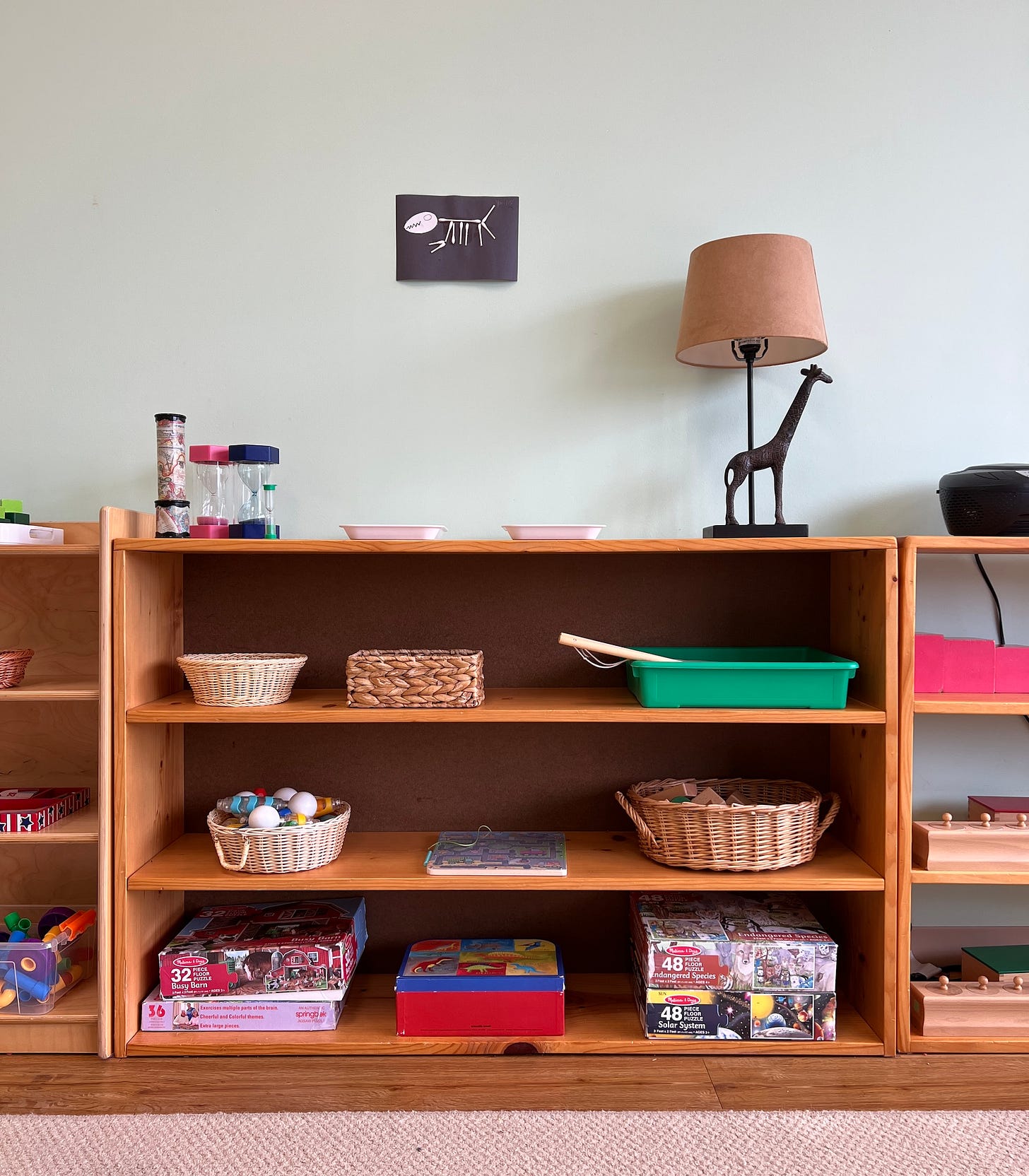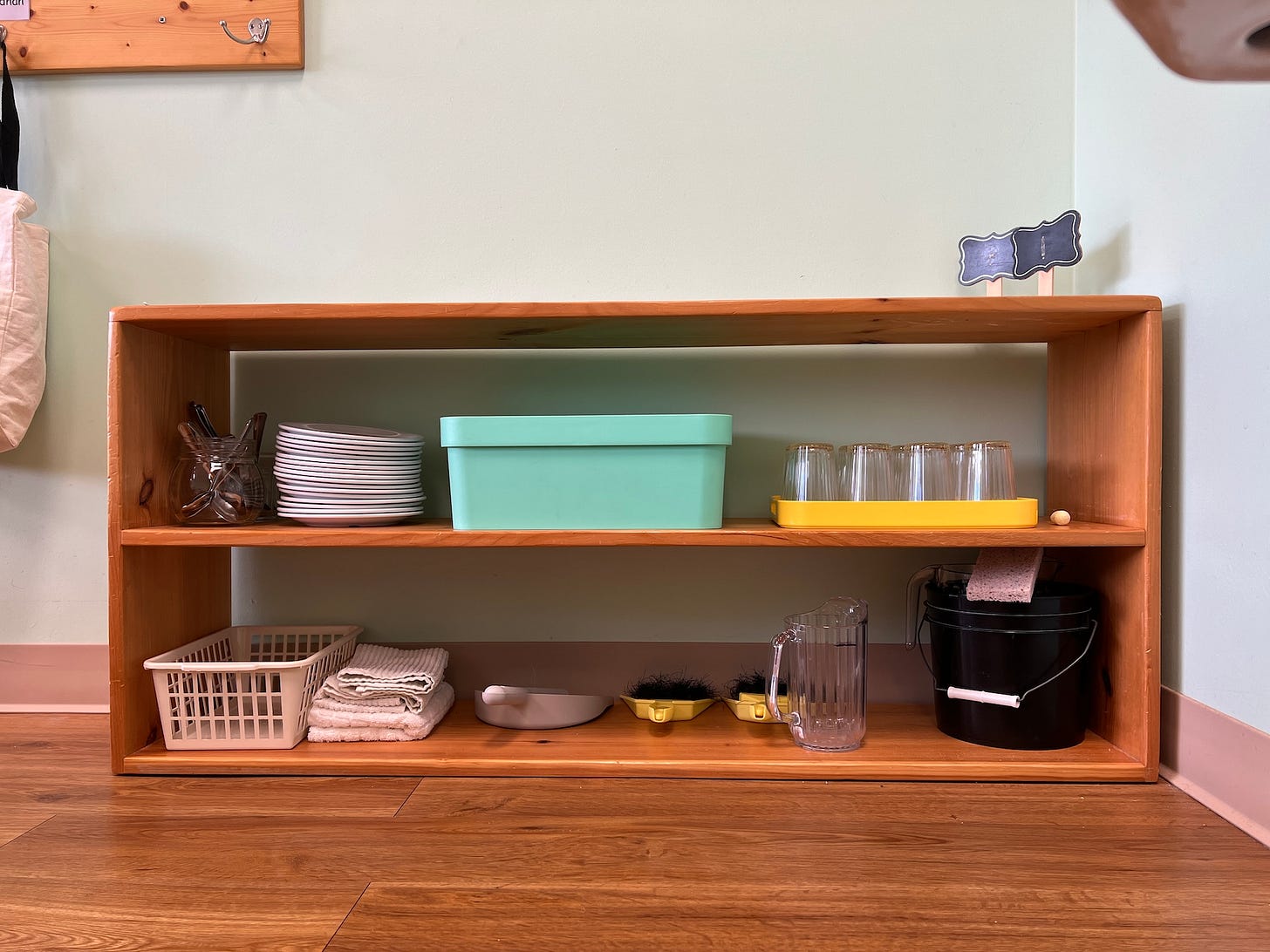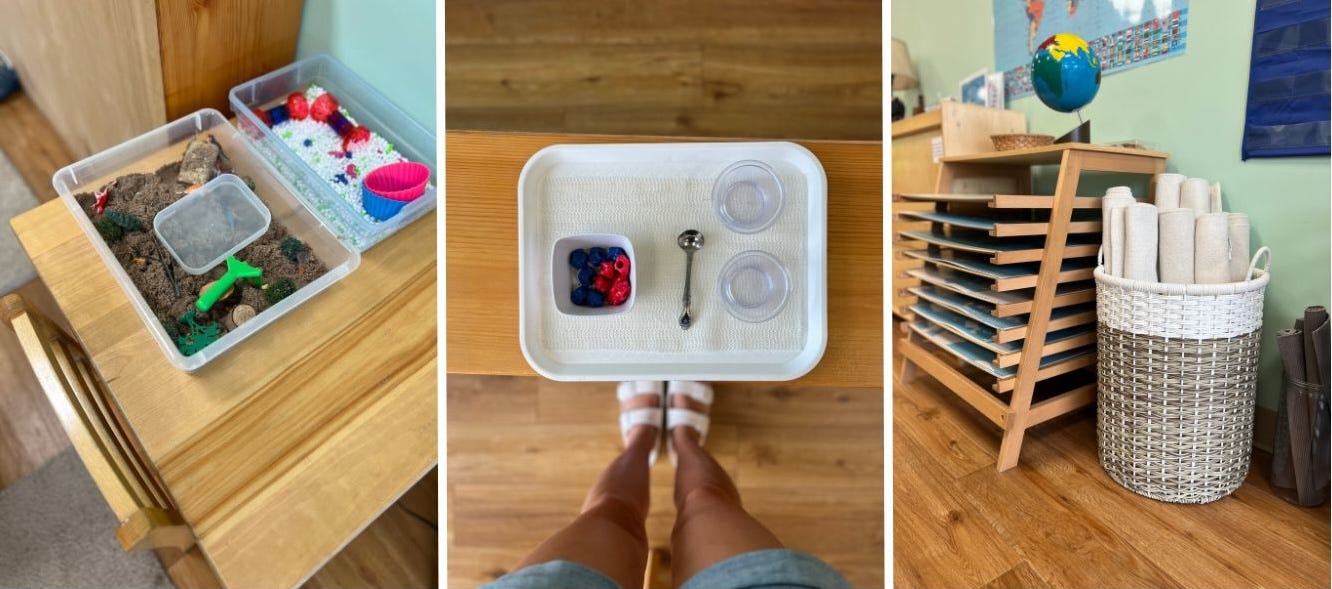Why we love our Montessori preschool
And how anyone can incorporate Montessori principles at home
While what initially attracted me to our Montessori preschool was that it was completely screen-free, we’ve grown to love it for so many other reasons. Several years in, John and I agree that sending our kids to this particular Montessori preschool has been one of the best decisions we’ve made as parents: they’ve been a key partner in raising our kids (thus far) to be healthy, happy, well-adjusted individuals, and what a gift that is!
Today, I thought we could chat about how the Montessori way has helped shape our family’s culture for the better, and also how we incorporate Montessori principles at home. Even if you have no plans to send your kids to a Montessori school, I hope you might find a few ideas to try with your own family!
Four Montessori principles we love:
Independence and freedom are encouraged.
AT SCHOOL: The Montessori environment is built on respect. From the youngest age, kids are given the respect of being seen as tiny learners who want to grow and can be trusted with independence and freedom. Because they are given this respect, they are in turn expected to respect themselves, their teachers, their classmates, and the classroom itself.1
With mutual respect as the foundation, kids have the freedom to explore within the limits of the classroom, making their own choices about how to spend their time and experiencing natural consequences. The teachers are guides, but mostly step back and allow the kids to explore.
By serving themselves snack from communal bowls, even toddlers get an early lesson in self-control and regulation. By making choices within the classroom, kids of all ages practice making decisions and becoming acquainted with their own likes and preferences.
AT HOME: This independence-to-competence-to-confidence flywheel is a powerful one. And we’ve been encouraged to activate it at home, too: I distinctly remember our director emailing out an eye-opening list of what three-year-olds can accomplish around the home, including cracking eggs, setting the table, and peeling cucumbers, all guided by the Montessori maxim “never help a child with a task at which he feels he can succeed.” Seeing our kids so independent and capable at school has helped us step back and be the guide at home — and continually reset our expectations for what they can do on their own.
One tiny example: a few weeks ago, another parent at our church small group dinner noticed that our three children — 8, 5, and 2 — had all filled their plates and were sitting down to eat without any help from us. (The 8-year-old had actually helped the two-year-old fill her plate, since she couldn’t reach the counter.) The other kids had all waited on their parents to fill their plates for them. They’re far from perfect, but this ability to exist more independently in the world seems to give our kids great confidence, satisfaction, and delight.
The prepared environment helps kids succeed.
AT SCHOOL: A big part of the Montessori philosophy is the “prepared environment,” and that a logically-arranged space creates inward order for young kids. If you’ve been in a Montessori classroom, you recognize the familiar elements: items stored on low shelving. Woven mats to create individual workspaces. Simple wooden materials. Items organized by color and size. Everything is age-appropriate, the right size for little hands, and geared towards the child’s developmental stage — a unique environment created just for them.2
Side note: when we first toured the classroom and imagined June in the toddler space, we found it hard to believe that she wouldn’t move through it like a tornado, indiscriminately yanking items off the shelves and tossing them around the room. But even toddlers are remarkably perceptive about adjusting to the norms of the spaces they find themselves. With gentle guidance from the teachers, she quickly learned the bounds of behavior and happily worked within them. Little kids want to please and are happy when they are set up to do so.
AT HOME: Our home is not a perfectly-prepared Montessori environment, but we’ve tried to arrange some key spaces so that the kids can take ownership of tasks and move independently. A few examples:
Buying clothes and shoes that allow our kids to get dressed independently.
Storing lunch boxes and backpacks in places they can reach.
Organizing toys in a simple system that’s easy to reset (mostly bins on low shelves).
Placing things we want them to have access to lower in the fridge.
The classrooms are mixed age.
AT SCHOOL: In a Montessori preschool, there are two categories of classrooms: the Toddler House, with kids ages 1.5-3, and the Children’s House, with kids ages 3-6. While this made me a little nervous at first (mostly just because it was different than what I was used to), it’s become one of my favorite aspects.
With mixed ages, kindness, courtesy, and patience for others is emphasized — and gets to be practiced each day.
The bigger kids teach, model behaviors for, and help littler kids. They’re held up as examples for the class and seen as leaders within it. The littler kids, in turn, are motivated to grow into the roles the bigger kids hold and the activities they get to do.
AT HOME: The skills needed to succeed in a mixed-age classroom easily translate to our home, where our kids need to get along with their mixed-age siblings. Our comfort level with mixed-age environments has also made it feel easier to shoo our kids outside into the neighborhood, where they regularly play with kids several years older and younger than them.
(If you’re curious about this idea, you might love reading The Coddling of the American Mind. The section on the benefits of mixed-age free play has really stuck with me, even years later!)
Minimal reports go home to parents.
AT SCHOOL: When our oldest daughter transferred in from a traditional daycare, the lack of information we got about her day was not a favorite aspect, and was actually kind of shocking to me: we were used to receiving a daily report on what she ate, when she slept, and how many diapers she went through.
In contrast, we got… almost nothing from our Montessori school. Of course, we were able to chat briefly with her teachers at the fringes of the day, and they were happy to give us a broad sketch of what she’d been up to, but there was no app or written report and it all felt a bit like a black box — which was unsettling, at first!
AT HOME: Now, though, I see it as a gift. The lack of data has freed us up early from our need to feel we have insight into and can control every aspect of our kids’ days. It’s building our trust muscle for when our kids are out of our care, a muscle that will only need to be exercised more and more as they grow. (More in this excellent essay.)
It’s not hard to see how an invisible line could be drawn between receiving daycare reports, to checking grades posted online, to tracking a teenager’s location. I’m as greedy as the next parent for information about my kids; I’m also grateful for a gentle exercise in letting go.
I hope this was helpful, friends! I always love learning about something new to me, and I hope these peeks into the Montessori way have done that today. (And speaking of peeks — all these photos are from our kids’ school. Doesn’t it look like a lovely place to spend the day?) I’d love to hear your thoughts, if you’d like to share!
This starts at the top: our director is gentle, no-nonsense, and old-school in the best way. Clear expectations are explained, enforced, and ultimately set everyone up for success.
Funny story: while the activities might be perfectly suited to kids, their value isn’t always obvious to adults. John and I distinctly remember watching a three-year-old methodically snip sections of yarn on our first school visit, the pile of yarn shards to his side growing ever larger, and being so confused. Now I get that he was practicing fine motor skills, attention, focus, etc. etc. but at the time, we just found it hilarious. References to the “yarn factory” come up far more often than you’d think six years in :)








Love these thoughts! While we don’t have a Montessori preschool near us, the “home” principles are definitely applicable to anyone!
Love this! Another benefit of not getting those daycare reports that Omar and I have learned recently has a lot to with parental expectations with having a toddler. Our daycare uses the reports app (kind of. If they have time they will add information but if things are hectic they won’t) and Omar and I realized we were using that to set expectations for how Penelope would be when she got home, which was affecting how we acted around her. If she didn’t nap well, we would be worried she was going to be grumpy and…would unintentionally act like she was grumpy. So now we avoid her reports all together, except for the messages her director sends and for photos/videos they occasionally post and it’s helped everyone. :) Her teachers are great about telling us if there was any kind of issue at school that day and so we just depend on that now.
I’ve also had friends mention that their daycares/preschools are moving to live streams which I have found so…interesting. Parents can watch their kids all day through the live stream, and it sounds like some do from what I’ve heard.